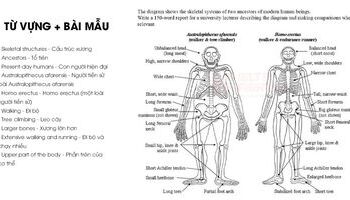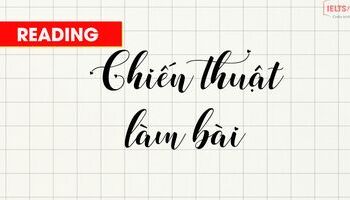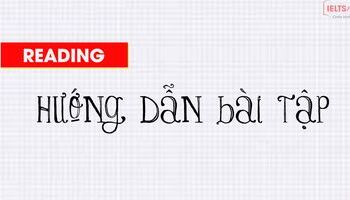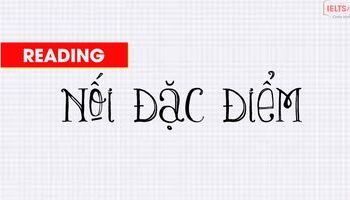Tiếp tục về các bài mẫu Writing Task 1 Process, hôm nay chúng ta cùng luyện viết đề bộ Xương khó nhằn nha.
Hướng dẫn viết bài
Đề bài:
The diagram shows the skeletal systems of two ancestors of modern human beings.
Write a 150-word report for a university lecturer describing the diagram and making comparisons where relevant.

Từ vựng quan trọng
- Skeletal structures - Cấu trúc xương
- Ancestors - Tổ tiên
- Present-day humans - Con người hiện đại
- Australopithecus afarensis - Người tiền sử loài Australopithecus afarensis
- Homo erectus - Homo erectus (một loài người tiền sử)
- Walking - Đi bộ
- Tree climbing - Leo cây
- Larger bones - Xương lớn hơn
- Extensive walking and running - Đi bộ và chạy nhiều
- Upper part of the body - Phần trên của cơ thể
- Broader chest and waist - Ngực và eo rộng hơn
- Rounded shape - Hình tròn
- Heads - Đầu
- Balanced - Cân đối
- Broader and lower shoulders - Vai rộng và thấp hơn
- Upper limbs - Các chi phần trên
- Elongated forearms - Cánh tay dài
- Tree climbing - Leo cây
- Shorter upper limbs - Các chi phần trên ngắn hơn
- Lower part of the body - Phần dưới của cơ thể
- Adaptations - Sự thích ứng
- Sustained running - Chạy liên tục
- Shorter femoral neck - Cổ đùi ngắn hơn
- Longer legs - Chân dài hơn
- Larger hip, knee, and ankle joints - Khớp hông, đầu gối và mắt cá châu bản hơn
- Smaller feet - Chân nhỏ hơn
- Shorter toes - Ngón chân ngắn hơn
- Larger heel bone - Xương gót chân lớn hơn
- Longer Achilles tendon - Gân Achilles dài hơn
- Stabilized foot arch - Cầu chân ổn định
- Partially developed arch - Cầu chân phần nào phát triển
Bố cục bài viết:
OVERVIEW: General Characteristics
A. Comparison of size and bone structure 1. Former (Australopithecus afarensis) had larger bones 2. Latter (Homo erectus) engaged in extensive walking and running
BODY 1 Chest and waist characteristics 1. Australopithecus afarensis had a broader chest and waist 2. Homo erectus had a more balanced head and broader, lower shoulders B. Head characteristics 1. Australopithecus afarensis had a more rounded head 2. Homo erectus had a more balanced head
BODY 2: Characteristics of upper limbs 1. Australopithecus afarensis had elongated forearms for tree climbing 2. Homo erectus had shorter upper limbs
Lower Body Features A. Adaptations for sustained running 1. Homo erectus had a shorter femoral neck, longer legs, and larger joints B. Characteristics of lower limbs and feet 1. Homo erectus had smaller feet, shorter toes, a larger heel bone, and a longer Achilles tendon 2. Australopithecus afarensis had a partially developed foot arch.
Conclusion.
Bài mẫu tham khảo
Band 7.5-8.0
Dưới đây là bài mẫu band 7.5+ do giáo viên IELTS Fighter viết:
The diagram depicts the skeletal structures of two ancestors of present-day humans, specifically Australopithecus afarensis and Homo erectus.
In general, accustomed to both walking and tree climbing, the former possessed significantly larger bones than the latter, which primarily engaged in extensive walking and running.
In the upper part of the body, characterized by a broader chest and waist, Australopithecus afarensis had a more rounded shape than Homo erectus. The same applies to their heads, although the head of latter was more balanced. However, Homo erectus had broader and lower shoulders. In terms of the 2 upper limbs, Australopithecus afarensis featured elongated forearms for more convenient tree climbing, while Homo erectus developed shorter ones.
Regarding the lower part of the body, Homo erectus displayed adaptations for sustained running, featuring a shorter femoral neck, longer legs, and larger hip, knee, and ankle joints. Additionally, Homo erectus had smaller feet with shorter toes, a larger heel bone, and a longer Achilles tendon, resulting in a stabilized foot arch, as opposed to the partially developed arch observed in Australopithecus afarensis.
(176 words)
Band 9
Mở rộng với bài mẫu band 9 nguồn từ IELTS Academic:
Variations in the skeletal systems of two early types of human are illustrated in this diagram. Overall, we can see that australopithecus afarensis had a heavier body and much longer arms, while homo erectus was slimmer and had more developed joints.
To begin with the upper half of the body, australopithecus afarensis had a much broader chest and waist than homo erectus, giving it a rounder appearance. The former had much longer arms and larger hands, which would have been useful for climbing trees.
As for the lower half of the body, we can see that homo erectus had proportionately longer legs and larger hip, knee and ankle joints. The feet of homo erectus were also smaller and more arched, with shorter toes. These differences meant that homo erectus was better suited to long-distance running.
In conclusion, we can see significant changes in the development of early humans from the diagram. Homo erectus is more similar to contemporary human beings with its long legs and arched feet. The physical differences are clearly related to differences in the lifestyles of tree climbers and endurance runners.
(183 words)
Trên đây là một số hướng dẫn, bài viết mẫu và từ vựng về đề này. Cả nhà cùng tham khảo và thử viết bài của riêng mình nhé.





